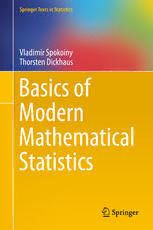
Basics of Modern Mathematical Statistics PDF
Preview Basics of Modern Mathematical Statistics
Springer Texts in Statistics Vladimir Spokoiny Thorsten Dickhaus Basics of Modern Mathematical Statistics Springer Texts in Statistics SeriesEditors: G.Casella R.DeVeaux S.E.Fienberg I.Olkin Forfurthervolumes: http://www.springer.com/series/417 Vladimir Spokoiny • Thorsten Dickhaus Basics of Modern Mathematical Statistics 123 VladimirSpokoiny ThorstenDickhaus WeierstrassInstitute(WIAS) WeierstrassInstituteforAppliedAnalysis Berlin,Germany andStochastics(WIAS) Mohrenstr.39 D-10117Berlin,Germany ISSN1431-875X ISSN2197-4136(electronic) ISBN978-3-642-39908-4 ISBN978-3-642-39909-1(eBook) DOI10.1007/978-3-642-39909-1 SpringerHeidelbergNewYorkDordrechtLondon LibraryofCongressControlNumber:2014949607 MathematicsSubjectClassification(2010):62Fxx,62Jxx,62Hxx ©Springer-VerlagBerlinHeidelberg2015 Thisworkissubjecttocopyright.AllrightsarereservedbythePublisher,whetherthewholeorpartof thematerialisconcerned,specificallytherightsoftranslation,reprinting,reuseofillustrations,recitation, broadcasting,reproductiononmicrofilmsorinanyotherphysicalway,andtransmissionorinformation storageandretrieval,electronicadaptation,computersoftware,orbysimilarordissimilarmethodology nowknownorhereafterdeveloped.Exemptedfromthislegalreservationarebriefexcerptsinconnection with reviews or scholarly analysis or material supplied specifically for the purpose of being entered and executed on a computer system, for exclusive use by the purchaser of the work. Duplication of this publication or parts thereof is permitted only under the provisions of the Copyright Law of the Publisher’slocation,initscurrentversion,andpermissionforusemustalwaysbeobtainedfromSpringer. PermissionsforusemaybeobtainedthroughRightsLinkattheCopyrightClearanceCenter.Violations areliabletoprosecutionundertherespectiveCopyrightLaw. Theuseofgeneraldescriptivenames,registerednames,trademarks,servicemarks,etc.inthispublication doesnotimply,evenintheabsenceofaspecificstatement,thatsuchnamesareexemptfromtherelevant protectivelawsandregulationsandthereforefreeforgeneraluse. While the advice and information in this book are believed to be true and accurate at the date of publication,neithertheauthorsnortheeditorsnorthepublishercanacceptanylegalresponsibilityfor anyerrorsoromissionsthatmaybemade.Thepublishermakesnowarranty,expressorimplied,with respecttothematerialcontainedherein. Printedonacid-freepaper SpringerispartofSpringerScience+BusinessMedia(www.springer.com) To mychildrenSeva, Irina,Daniel, Alexander,Michael,andMaria To myfamily Preface Preface ofthe FirstAuthor Thisbookwaswrittenonthebasisofagraduatecourseonmathematicalstatistics givenatthemathematicalfacultyoftheHumboldt-UniversityBerlin. Theclassicaltheoryofparametricestimation,sincetheseminalworksbyFisher, Wald, andLeCam, amongmanyothers,hasnowreachedmaturityandanelegant form.Itcanbeconsideredasmoreorlesscomplete,atleastfortheso-calledregular case.Thequestionoftheoptimalityandefficiencyoftheclassicalmethodshasbeen rigorouslystudiedandtypicalresultsstatetheasymptoticnormalityandefficiency ofthemaximumlikelihoodand/orBayesestimates;seeanexcellentmonographby IbragimovandKhas’minskij(1981)foracomprehensivestudy. In the time around 1984 when I started my own Ph.D. at the Lomonosoff University, a popular joke in our statistical community in Moscow was that all the problems in the parametric statistical theory have been solved and described in a complete way in Ibragimov and Khas’minskij (1981), there is nothing to do anymoreformathematicalstatisticians.Ifatall,onlyfewnonparametricproblems remainopen.AfterfinishingmyPh.D.Ialsomovedtononparametricstatisticsfor a while with the focus on local adaptive estimation. In the year 2005 I started to write a monograph on nonparametric estimation using local parametric methods whichwassupposedtosystemizemypreviousexperienceinthisarea.Theveryfirst draft of this book was available already in the autumn 2005, and it only included few sections about basics of parametric estimation. However, attempts to prepare a more systematic and more general presentation of the nonparametrictheory led mebacktotheverybasicparametricconcepts.In2007Iextendedsignificantlythe part about parametric methods. In the spring 2009 I taught a graduate course on parametricstatisticsatthemathematicalfacultyoftheHumboldt-UniversityBerlin. My intention was to present a “modern” version of the classical theory which in particularaddressesthefollowingquestions: what doyouneedtoknow from parametric statisticstoworkonmodernparametric and nonparametricmethods? vii viii Preface howtoidentifytheborderlinebetweentheclassicalparametricandthemodernnonpara- metricstatistics? Thebasicassumptionsoftheclassicalparametrictheoryarethattheparametric specification is exact and the sample size is large relative to the dimension of the parameterspace. Unfortunately,this viewpointlimits applicability of the classical theory:itisusuallyunrealistictoassumethattheparametricspecificationisfulfilled exactly.So, the modernversionof the parametrictheoryhas to include a possible model misspecification. The issue of large samples is even more critical. Many modern applications face a situation when the number of parameters p is not only comparable with the sample size n, it can be even much larger than n. It is probably the main challenge of the modern parametric theory to include in a rigorouswaythecaseof“largep smalln.”Onecansaythattheparametrictheory thatisabletosystematicallytreattheissuesofmodelmisspecificationandofsmall fixedsamplesalreadyincludesthenonparametricstatistics.Thepresentstudyaims at reconsidering the basics of the parametric theory in this sense. The “modern parametric”viewcanbestressedasfollows: - anymodelisparametric; - anyparametricmodeliswrong; - evenawrongmodelcanbeuseful. Themodelmentionedinthefirstitemcanbeunderstoodasasetofassumptions describing the unknown distribution of the underlying data. This description is usually given in terms of some parameters. The parameter space can be large or infinite dimensional, however, the model is uniquely specified by the parameter value.Inthissense“anymodelisparametric.” The second statement “any parametric model is wrong” means that any imag- inary model is only an idealization (approximation) of reality. It is unrealistic to assume that the data exactly follow the parametric model, even if this model is flexible and involves a lot of parameters. Model misspecification naturally leads to the notion of the modeling bias measuring the distance between the underly- ing model and the selected parametric family. It also separates parametric and nonparametricviewpoint. The parametric approach focuses on “estimation within the model” ignoring the modeling bias. The nonparametric approach attempts to accountforthemodelingbiasandtooptimizethejointimpactoftwokindsoferrors: estimationerrorwithinthemodelandthemodelingbias.Thisvolumeislimitedto parametricestimationandtestingforsomespecialmodelslikeexponentialfamilies or linear models.However,it preparessome importanttoolsfor doingthe general parametrictheorypresentedinthesecondvolume. Thelaststatement“evenawrongmodelcanbeuseful”introducesthenotionofa “useful”parametricspecification.Insomesenseitindicatesachangeofaparadigm intheparametricstatistics.Tryingtofindthetruemodelishopelessanyway.Instead, oneaimsattakingapotentiallywrongparametricmodelwhich,however,possesses some useful properties. Among others, one can figure out the following “useful” features: Preface ix - anicegeometricstructureofthelikelihoodleadingtoanumericallyefficientestimation procedure; - parameteridentifiability. Lack of identifiability in the considered model is just an indication that the considered parametric model is poorly selected. A proper parametrization should involve a reasonable regularization ensuring both features: numerical efficiency/stability and a proper parameter identification. The present volume presentssomeexamplesof“usefulmodels”likelinearorexponentialfamilies.The second volume will extend such models to a quite general regular case involving some smoothness and moment conditions on the log-likelihood process of the consideredparametricfamily. This book does not pretend to systematically cover the scope of the classical parametric theory. Some very important and even fundamental issues are not consideredatallinthisbook.Onecharacteristicexampleisgivenbythenotionof sufficiency,whichcanbehardlycombinedwithmodelmisspecification.Atthesame time,muchmoreattentionispaidtothequestionsofnonasymptoticinferenceunder modelmisspecificationincludingconcentrationandconfidencesetsindependence of the sample size and dimensionality of the parameter space. In the first volume we especially focus on linear models. This can be explained by their role for the generaltheoryinwhichalinearmodelnaturallyarisesfromlocalapproximationof ageneralregularmodel. This volume can be used as textbook for a graduate course in mathematical statistics. It assumes that the reader is familiar with the basic notions of the probability theory including the Lebesgue measure, Radon–Nycodim derivative, etc.Knowledgeofbasic statistics isnotrequired.I triedto beasself-containedas possible;themostofthepresentedresultsareprovedinarigorousway.Sometimes thedetailsarelefttothereaderasexercises,inthosecasessomehintsaregiven. Preface ofthe SecondAuthor It was in early 2012when Prof. Spokoinyapproachedme with the idea of a joint lecture on Mathematical Statistics at Humboldt-University Berlin, where I was a juniorprofessoratthattime.Uptothen,myowneducationinstatisticalinference hadbeenbasedontheGermantextbooksbyWitting(1985)andWittingandMüller- Funk(1995),andforteachinginEnglishIhadalwaysusedthebooksbyLehmann andCasella(1998),LehmannandRomano(2005),andLehmann(1999).However, IwasawareofProf.Spokoiny’sowntextbookprojectandsothequestionwaswhich texttouseasthebasisforthelecture.Finally,thefirstpartofthelecture(estimation theory) was given by Prof. Spokoiny based on the by then already substantiated Chaps.1–5 of the present work, while I gavethe second part on test theory based on my own teaching material which was mainly based on Lehmann and Romano (2005).
